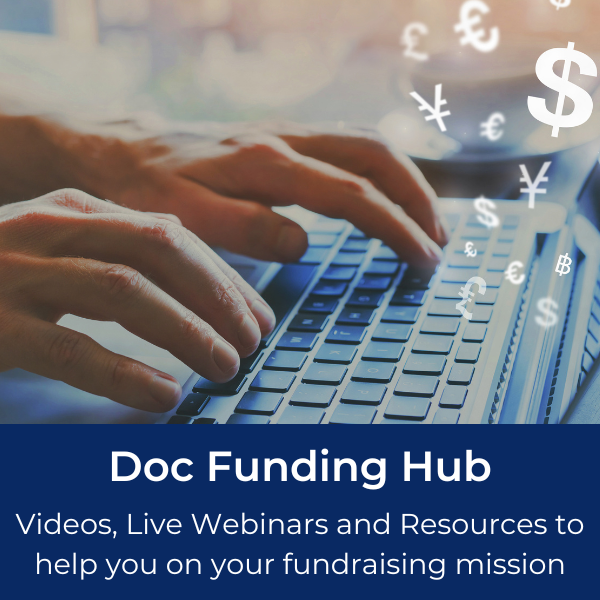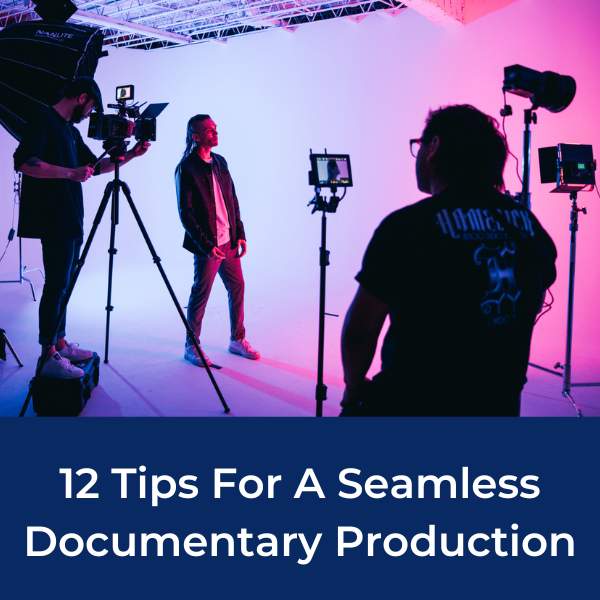Crowd Funding for Documentaries
Tips for Success
“People give money to an idea they are passionate about or a story that is too compelling to ignore. Your pitch should be one, or both, of these things.”
- IndieGoGo
What is Crowd Funding?
Crowd funding (or crowdfunding) is fantastic way to jumpstart fundraising for your documentary.
Basically it means you are raising money with a “crowd” or you are asking numerous individuals (a crowd of people) to each give a little so that it adds up to a lot. For example, you ask 100 people to each donate $100 which ads up to $10,000.
Since most documentary filmmakers work independently without the backing of a studio, and because grants can be tough to get, crowdfunding has become a popular choice for many doc producers. It’s a great way to not only launch your fundraising effort, but also to test the viability of your documentary idea.
Crowd funding has become synonymous with sites like IndieGogo and KickStarter, but you can certainly conduct your own crowd funding campaign on your own website and/or through social networking sites like Facebook and Twitter.
Here's How It Works | Tips for Success
- DOCUMENTARY TRAILER: Create a trailer for your documentary – this step should not be skipped!!! According to IndieGoGo, campaigns with videos raise 122% more money than those without.
- FUNDRAISING PAGE: Set up a special fundraising page on your own website or go through an existing online fundraising system such as IndieGoGo or KickStarter. Your fundraising page will include a compelling pitch for your film, your trailer and a donate button.
- SET A GOAL: Set a specific fundraising goal for a specific purpose (example, set a goal to raise $10,000 to jumpstart your documentary project and shoot your first 10 interviews).
- SET A DEADLINE: People want to know there’s an end in sight.
- CREATE INCENTIVES: Come up with creative “gifts” for your donors such as a VIP pass to your documentary premiere, signed movie posters, director’s cut DVD, a credit in your film, etc.
- GET THE WORD OUT: Send out a blast e-mail to anyone you can think of announcing the campaign. Post the campaign on your Facebook and Twitter feeds, yours and others blogs, relevant websites, send press releases, basically shout from the mountain top about your campaign. A great e-mail marketing program is AWeber.
- SEND UPDATES: According to IndieGoGo, campaigns that send 11 or more updates raise 137% more money than those that don’t. They recommend sending one e-mail update per week to fans and supporters throughout the campaign.
- FOLLOW-UP! Once your campaign is done, make sure to send everyone an update and a big thanks to those who contributed. And make sure to follow-up with the promised gifts. (Tip! Not following up will do serious damage to your credibility and will hurt any future campaigns) So send plenty of thank you's and updates... they'll love you for it!
Documentary on Korean Education – KickStarter Campaign Video
Two Models of Crowd Funding:
- Traditional (IndieGoGo): Set a goal and commit to raising the funds no matter how long it takes. The maximum length for a campaign on IndieGogo is 120 days, although they recommend a 60 – 70 day campaign. Whether or not you reach your goal, you keep all cash raised.
- “All-Or-Nothing” (KickStarter): This is a deadline-crises-centered model of fundraising where you only get to keep the funds raised if you meet your fundraising goal. KickStarter recommends a campaign no longer than 30 days to create excitement. According to KickStarter, “longer durations incite less urgency, encourage procrastination and tend to fizzle out.”
Personally, I like the “all-or-nothing” format for a documentary fundraising campaign where you set a specific goal (say $5,000) to be raised within a specific timeframe (say 25 days) and if the goal is not reached, you get nothing. That’s right, all the money people pledged for your film is given BACK to them if the goal is not reached. This aspect of KickStarter makes a lot of filmmakers nervous. But I think it’s what makes the model so brilliant.
Two Reasons I like the KickStarter model:
- Crisis - The simple fact is that people will respond to a crisis. The potential of getting so close to your goal and then losing it all will often compel more people to donate and donate more quickly. A crisis creates emotion and excitement and provides an added incentive to get people moving. The KEY here is to create a goal that you feel sure you can meet because you don’t want to lose that funding and it’s really hard to go back to the same people and ask them to donate again to a project that seems like a “loser”.
- Peace of Mind - It provides supporters the peace of mind that their money won’t be wasted on a project that never gets made (or gets made poorly) because it didn’t get enough funding. People like to know they are part of something successful!
That said, there is absolutely nothing wrong with conducting a fundraising campaign without the “crisis element”. If your documentary idea is strong, you have a compelling trailer and you do adequate promotion, you can raise thousands of dollars.
Documentary filmmaking team Jilann Spitzmiller and Hank Rogerson (instructors here at Desktop Documentaries) recently completed a crowd funding campaign with IndieGoGo and raised more than $20,000 for their latest documentary STILL DREAMING.
Keep in mind that KickStarter and IndieGoGo keep a percentage of the funds you raise. Considering they are providing a ready-made system for you, it seems to me a fair trade.
Crowd Funding How-To
For a quick overview of how a crowd funding campaign works, check out the KickStarter Creator HandBook or visit the IndieGoGo Education Center.
Crowd funding is covered in much more detail in our documentary fundraising course: Lights, Camera, Pitch! Documentary Cash-Winning Guide.
Expert Crowdfunding Advice For Filmmakers
Learn from 10+ experts about film funding, including Seed&Spark Founder Emily Best ("Why people fail at crowdfunding") and filmmaker Spike Lee who raised $1.4-million on Kickstarter. Thanks to Film Courage for this amazing compilation.
Learn more about documentary fundraising.
DIY Crowd Funding
You can certainly do a crowdfunding campaign on your own using your own website or the website of a supporter. The benefits of using something like KickStarter is that they have everything set up and ready to go for you. And it gives your project credibility by posting your project on a professional platform. In addition, they get huge amounts of traffic to their sites which could result in additional donations.
However, by doing a campaign on your own website, you could potentially save a chunk of cash in fees. But you really need to feel confident in your ability to bring people to your site and then have a good system in place to take their donation, gather contact info and thank them.
What is YOUR experience with crowdfunding?
What lessons have your learned with crowdfunding? What works? What doesn't? Got a crowdfunding question? Share your crowdfunding questions and stories here.
Crowdfunding Stories and Feedback
Click below to read about other people's experiences with crowdfunding.
KickStarter Campaign Just Launched | Fundraising Advice Needed!
We have just launched our Kickstarter campaign for our documentary "The Dead Affect" which follows the hit series "The Walking Dead" back to its roots …
Crowdfunding - with Jennifer Fox and Katherine Nolfi
Jennifer Fox's newest documentary film MY REINCARNATION raised $150,456 via Kickstarter, more than any other completed film in the history of the crowdfunding …
Related Articles
- Documentary Fundraising: How to Raise Money for Your Film
- Documentary Film Grants
- How To Write A Documentary Treatment/Proposal
- Crowdfunding For Filmmakers | 5 Questions Before Launching
Documentary Resources
Ready To Make Your Dream Documentary?
Sign up for our exclusive 7-day crash course and learn step-by-step how to make a documentary from idea to completed movie!



















